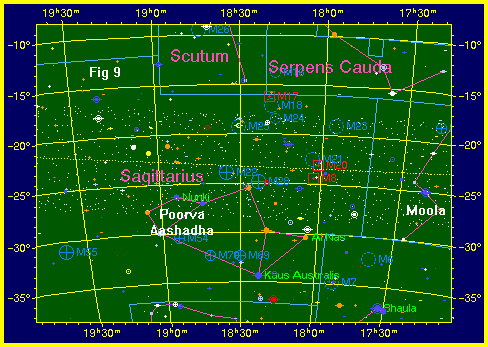 |
 |
|||||||||
|
||||||||||
Introduction Bharateeya Nakshatra system History of star names Loadstar software Mesha or Aries Vrishba or Taurus Mithuna or Gemini Karkataka or Cancer Simha or Leo Kanyaa or Virgo Tula or Libra Vrischika or Scorpio Dhanu or Sagitarius Makara or Capricorn Kumbha or Aquarius Meena or Pisces Conclusion Appendix References
|
Figure 9 shows 30 degrees square area around Dhanu Raashi. The Nakshatras in this figure are Vichruta/Moola, and Poorvaashada. Both the stars are in the moon traverse band. For the imaginative, a stretched bow can be seen in the Dhanu Raashi. Vichruta or Moola Nakshatras considered to be a star mansion with eleven stars.
The following table presents candidate stars, which qualify as Moola based on brightness, location with reference to moon traverse band, and distance from previous Nakshatra.
If one star is to be identified as Moola, then the best candidate for Moola or Vichruta Nakshatra is 42 q OPH from Ophichius zodiac of the European system. It falls in the star band and is 50 minutes or 13 degrees (E-W) away from Jyeshta. Its brightness is +3.28. Arab Sabik is another strong candidate for Moola with +2.43 brightness and is also 13 degrees from Jyeshta. Moola or Vichruta has been extensively referred to in Atharveda Kaanda 2,Kaanda 3 and kaanda 6 (Ref 2). Vichruta, stands for darkness and Moola carries an adjective Arishta. This word has two meanings, one standing for sweet and second associated with bad associated with death. Astronomically, Moola is in line with Milkiway galactic center. Did some astronomical event appear 5000 years ago near the center of Milkiway galaxy, which could explain why Moola is considered as bad? In modern astronomy, there have been conjectures of a black hole at the center of our Milkiway. This area of sky is visually dark because large amount of matter is presumed to exist around the center of the Galaxy. Did vedic period astronomers know of the center of the galaxy or did they see some astronomical event justifying the bad omen associated with Moola?. Poorvaashaada Nakshatra is considered to be a star mansion of two stars. The following table presents candidate stars, which qualify as Poorvashaada based on brightness, location with reference to moon traverse band, and distance from previous Nakshatra.
If one star is to be identified as Poorvaashadha, it is 34 aSag, which has an Arab name Nunki. Its brightness is +2.06. There are other stars nearby and one which has a brightness of 1.8. But it is far away from the moon traverse band, and hence is not a good candidate for Poorvaashada. Poorvaasaahda is 80 minutes or 20 (E-W) degrees away from Moola. Uttarashaada is considered to be a star mansion of two stars. It is shown in figure 10. The following table presents candidate stars, which qualify as Uttarashaada based on brightness, location with reference to moon traverse band, and distance from previous Nakshatra.
If one star is to be identified for Uttaraashada, it is the twin star 5a/6a2 both in Capricorn Zodiac. They are of brightness 4.24 and 3.56.Together the pair appear as one star. The SAO identities are SAO-163422/163427 or HD -192876/192947. There is a large gap between Poorvaashada and Uttaraashaada of nearly 22 degrees (E-W). There are no likely candidate stars for Uttaraashaada in the 22 degrees in the moon traverse band or near by. Arabs call this as Geidi associated with slaughter of sheep. In Raashi/Nakshatra translation, whole of Moola and whole of Poorvaashaada are treated as Dhanu Raashi, while 1/4 of Uttaraashaada is a part of Makara Raashi.
|
||||||||||||||||||||||||||||||||||||||||||||||||||||||||||||||||||||||||||||||||||||||||||||||||||||||||||||||||||||||||||||||||||||||||||||||
